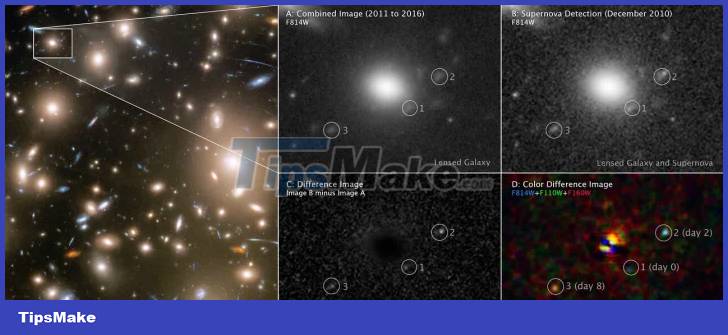Hubble Telescope extremely rare photo of the moment of the Supernova explosion
In simple terms, a Supernova (also known as a supernova) is a giant final explosion that marks the destruction of a star, occurring in the final stages of the evolution of massive stars. large, creating a "new" star with an intense light source, before gradually fading within a few weeks to a few months.
A Supernova event can produce a source of light so powerful that it outshines the entire galaxy, causing every other star in its galaxy to 'dim'. But that light source didn't last long - just the blink of an eye in terms of cosmic time. This, combined with the unpredictable nature of supernova events, makes capturing the moment the event takes place extremely rare. However, the Hubble Space Telescope recently showed its importance in the field of astronomy by bringing back to humanity three different moments of a supernova event in a single photo. .
It is very rare that a supernova can be detected at an early stage, as this stage lasts only a moment. It only lasts for a few hours to a few days, and can be easily missed even at a short distance. In the same exposure. However, Hubble did an excellent job at that difficult task. A sequence of images can be seen — like different views of a supernova.
 Hubble Telescope extremely rare photo of the moment of the Supernova explosion Picture 1
Hubble Telescope extremely rare photo of the moment of the Supernova explosion Picture 1
The reason three different points can be seen at the same time is due to a phenomenon called gravitational lensing, in which a massive object lies between us and the object being observed. If the intermediate object is large enough, its gravity will warp space, changing the visibility of the object behind it. That background object can appear brighter when the intermediate object acts as a magnifying glass, and it can also appear at a different point in space when its light is bent. In this case, the light from the supernova is bent along three paths of different lengths, so the light arriving at Hubble shows three different aspects.
Overall, this is a very distant supernova event, meaning it happened a long time ago. Scientists estimate that this event occurred 11 billion years ago, close to the beginning of the universe's formation (13.8 billion years ago). This is one of the earliest supernovae observed in such detail. Thanks to three different timestamps captured in the image, researchers were able to measure the size of the star that created the explosion. This star is estimated to be about 500 times larger than the sun, most likely a rare red super giant.
You should read it
- The supernova exploded twice in the universe, surprising astronomers
- The world's most expensive telescope captures stunning views of the famous supernova remnant
- The mysterious flaw developing in supernova Tycho is astonishing to the scientific world
- One of the brightest stars in the sky is about to explode
- The Most Powerful Space Telescope Ever Built Will Look Back In Time To The Dark Ages Of The Universe
- The day you were born, is there anything special about space? NASA will help you observe with Hubble
- Admire the giant stars forming in the corner of the Tarantula Nebula
- The Hubble Space Telescope: A Retrospective With Dr. Steven Hawley
- The 7 largest objects people ever launched into space
- The number of galaxies in the universe is 10 times more than what astronomers thought before
- Lonely star glitters in the background of an amorphous galaxy in the eyes of the Hubble telescope
- Admire the majestic spectacle of swirls of dust and gas in nearby galaxies
May be interested

The Orion spacecraft successfully launched, beginning its journey to explore the Moon

NASA successfully sent a software update to Voyager 2 from a distance of 19.9 billion km

Admire incredibly detailed images of the Orion Nebula through the eyes of the James Webb telescope

Clouds on Neptune may be created by the Sun

How many planets are there in the universe?

Why are the stars in the universe spherical and not square or rectangular?






 The Tarantula Nebula appears beautifully through the eyes of the Hubble telescope
The Tarantula Nebula appears beautifully through the eyes of the Hubble telescope The Hubble Telescope sent back to Earth its first photo after changing its operating method
The Hubble Telescope sent back to Earth its first photo after changing its operating method Lonely star glitters in the background of an amorphous galaxy in the eyes of the Hubble telescope
Lonely star glitters in the background of an amorphous galaxy in the eyes of the Hubble telescope Hubble telescope discovers more than 1,000 new asteroids
Hubble telescope discovers more than 1,000 new asteroids The Hubble Telescope finds a galaxy glowing strangely from behind a dark nebula
The Hubble Telescope finds a galaxy glowing strangely from behind a dark nebula The supernova exploded twice in the universe, surprising astronomers
The supernova exploded twice in the universe, surprising astronomers